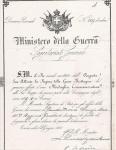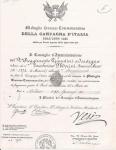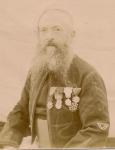
tjnier
For Deletion-
Posts
35 -
Joined
-
Last visited
Profile Information
-
Location
Corpus Christi, Texas, USA
Recent Profile Visitors
The recent visitors block is disabled and is not being shown to other users.
tjnier's Achievements
-
The Cross of Merit of War - Italian Medal
tjnier replied to djg145's topic in The Great War 1914 to 1918
Dave: It turns out that your CSM William Woodhead also won the Mlitary Medal !! Woodhead's award of the Italian War Merit Cross appears in the London Gazette of 17 May 1919, page 6208. He is listed as "15421 Company Serjeant-Major William Woodhead, M.M.,12th Battalion, Durham Light Infantry. (Castleford, Yorks.). Castleford would have been his residence at the time of his enlistment, when he was assigned his regimental service number 15421. Now you need to inquire where the Woodhead M.M. is located today. Also, you can find his M.M. award in the London Gazette by checking through its name indexes, especially those for the period 1917-1919. Best wishes andr good luck in your research!! --- Tom Nier -
Italy Italy - British Crimean medal to Sardinian Troups
tjnier replied to Veteran's topic in Southern European & Balkan States
http://gmic.co.uk/uploads/monthly_08_2014/post-8573-0-73908800-1408981768.jpghttp://gmic.co.uk/uploads/monthly_08_2014/post-8573-0-75227300-1408981786.jpgAttached is an example of the Sardinian brevetto (= certificate) for the British Crimea medal. It is made out to "Grenadier Francesco Mario Morini, 2nd Regt. of Sardinian Genadiers." Attached also is Morini's brevetto for the French medal for the Italie 1859 campaign. By then, Morini had become a Drummer (Tamburino) in the 2nd Regt. -
Uncategorised Order of the Black Star
tjnier replied to blackthorn's topic in The Great War 1914 to 1918
The Great War produced a high demand for French decorations for the Allies fighting alongside French Troops. Whereas the Allies had or expanded their series of military decorations, the French had only the Legion of Honor. In order to preserve the prestige of the LOH, various junior French orders were pressed into service, being awarded outside of their original purpose and context. These included the Black Star, the Academic Palms, the Agricultural Merit, and the Medals of Honor from the various French ministries. Thus the LOH could be reserved for the most outstanding services rendered, or for award to just the most senior officers. Lesser degrees of service, and lower ranking officers were placated with these other decorations. -
The Cross of Merit of War - Italian Medal
tjnier replied to djg145's topic in The Great War 1914 to 1918
Hello Dave: The simple answer is that the 12th Durham Light Infantry served in Italy from November 1917 up to Austria's armistice on 4 Nov. 1918. After the disastrous Italian defeat at Caporetto, a joint British-French force was sent to support the Italian front against further Austrian gains. A search of the London Gazette has located 758 awards of the Italian War Merit Cross to British personnel. -
Hello Veteran: Many thanks for your analysis of this interesting photograph, especially the identification of the hunting horn at the elbow of his sleeve as a marksmanship badge. I re-examined the three stripes under a hand lens. They all have the same dimensions, herringbone weave, and shade of gray (which suggests the same color). Would this indicate a sergeant's rank, or were re-enlistment stripes identical to rank stripes in size and color?? In the bend of the bottom chevron is a flaming bomb, and immediately below it is a crossed pair of single blade axes. The axes should confirm his status as a Sapper, which is reflected in his full beard and what appears to be his leather apron around his waist. The weakest evidence is what appears to be a shoulder tag along the upper seam of his sleeve with the jacket. Under a hand lens, a few letters appear to my eye which fall into the legend "legion etrangere". But my eye may be deceiving me. I would gladly mail this photograph to a GMIC member who is an expert on French Army uniforms, for an independent opinion. Can anyone recommend such an expert??
-
Hendrik: Thanks for your insight about the "Italie 1859" medal possibly being the Italian Independence Wars medal. However, the Independence medal is usualy observed with one or more dated clasps which indicated the veteran's specific campaign(s). I can't detect any clasps on this man's medal. Chris: This veteran may well have served in another unit of the French Army. I take it that the posthorn insignia visible at his left elbow implies that he had served in the Chasseurs a pied ou monte?
-
Sometimes one can derive considerable information about a veteran by studying his photograph. Attached is a portrait of such a French Army veteran, with a close-up of his medals. He wears the Legion of Honor, Chevalier, and the Medaille Militaire, both Third Republic models. Next is a colonial medal with two rectangular clasps. The fourth medal on his top row appears to be the 1870-71 War Medal. The bottom row shows what looks to be the Italie 1859 medal, followed by the 5th class badge of the Tunisian Order of Nichan Iftikhar. His left shoulder sleeve insignia has the three chevrons of a Sergent-Chef, or Senior Sergeant. Using a hand lens,a crossed pair of single blade axes is visible right below the chevrons. So this soldier had served in one of the elite Sapper units of the French Army. Their hazardous duty won them the privileges of having a full beard, wearing a leather apron & gloves, and carrying the axe instead of a rifle.when on parade. The wide light band around this veteran's waist is his leather apron. Additional study of this veteran's upper sleeve next to the jacket seam, revealed enough letters to identify the shoulder tag "LEGION ETRANGERE". So this man was a veteran of a Sapper unit of the Foreign Legion. His photo had to have taken sometime after 1911, the year of institution of the 1870-71 medal. Assuming he served in the Italie 1859 campaign at the age of 18, his birth year would be 1841. Thus he would have been about age 70 when he sat for his photograph by 1911.
-
Italy Al Valore Militare after 1945
tjnier replied to dedehansen's topic in Southern European & Balkan States
You may be interested to know that Journal OMSA will be publishing my in-depth article on the Al Valore MIlitare medals. I am told it is scheduled for the May-June 2013 issue. The article covers AVM varieties dating from 1849 to World War 1. Regards to all, Tom Nier -
Italy- Unusual Cross for military valour
tjnier replied to tjnier's topic in Southern European & Balkan States
While there is so much interest in the War Merit Cross varieties, I have another question for the Club members. I have examples of the WMC each with one of several hallmarks on the lower reverse arm, placed near the lower right corner. These include the crown over Z mark of the Royal Mint, which specimen was awarded to a British Artillery Major in WW1. The other single letter hallmarks known to me include "M", "R". "F" struck in relief, and "B" incused into the Cross. Does anyone have a clue as to the meaning of these letter hallmarks?? Are there more letter hallmarks known to be or observed on the WMC?? One theory bandied about is that they represent manufacture in Rome, Milan, Firenze, and Bologna. However, my Italian contacts say they have never heard of this theory. They suspect the letters correspond to local firms making the Crosses, not to the cities of manufacture. Would be glad to receive any new information on this subject from the Club members. Many thanks, Tom -
Italy- Unusual Cross for military valour
tjnier replied to tjnier's topic in Southern European & Balkan States
I apolgize for my delay in reply to the question of the actual ribbon on the AVM cross with the "Xa" stamped over the VE III monogram. The ebay listing in March 2011 showed that it had a plain blue ribbon. I did not win this eBay item. Many thanks to the Club members who provided so much information about this unusual AVM Cross. -
The topic of BWM awards to European civilians was discussed by Anthony Margrave in his quarterly journal on French medals titled "Honneur et Patrie, October 1997, Vol. 6, #3, pages 24-26 (this journal is now discontinued). He quoted a reference that 4127 British War Medals were awarded to British, Belgian & French civilians who worked as agents for the BEF in France during the war. These names were in a record box titled "British War and Victory medals. Agents, British, Belgian, French" which was housed at the Public Records Office, Kew, as Record Group 329/2356. The French recipients were in a manuscript dated 7 August 1919, which consisted of 17 typed pages. It listed the names and addresses of the French civilians, men & women entitled to the BWM. There was a note in the record box stating that 269 BWMs for French citizens were to be named, and 9 more were to be left blank. Alec Purves in his book "Medals, Decorations & Orders of the Great War 1914-1918" stated that 133 silver and 573 bronze BWMs were awarded to European civilians who aided the BEF in France. None of these medals were named as issued, according to Purves. An article by Marcel Nuikttens on the BWM awards to Belgian citizens was published in the Winter 1991 issue of Journal OMRS, Vol. 30, #4, pages 181-283.
-
Italy - Italian traslation please
tjnier replied to army historian's topic in Southern European & Balkan States
I obtained this 1950 photograph from a dealer in Argentina. Some his medals are too obscure to be examined under a lens, but most of them can be identified. The top row of 3 consists of an unknown cross, a War Merit Cross, and a WW! Commemorative medal with two clasps. The second row of 4 contains a WW1 Victory meda, a United Italy medal, an obscured medal, and a very prominent Third Army cross. The bottom row has only one obscured medal. The unknown cross in the 1st row reminds me of the Order of St.John of Jerusalem. Its member medal has a black ribbon. -
Here is an unusual variety of the Italian Cross of Military Valor. It appeared in an eBay auction that closed on 3-27-2011. What is different is that the King's monogram "VE" on the upper reverse arm has been overstamped with a large "X" and a small "A" (in the upper right corner). It came in a fitted maroon case with the Cravanzola hallmark printed on the inside of its lid. The seller believed that this mark represented its award to a member of the elite 10th MAS. This was an Italian Navy group of commandos that manned human torpedoes against British warships, and performed other daring activities in WW2. It was also suggested that this overstamp indicated the abdication of the Italian King after the Italian surrender to the Allies in 1943. Does any GMIC member have a correct explanation of this interesting overstamp??
-
The official issue of the 1870 Independence medal has the die designer's name "CANZANI" struck in relief on both faces. It appears right below the bust of King VE II at his neckline. It also appears below the toga & shield of the female figure on the reverse. I have seen privately struck varieties of this medal, particularly ones with the "S.J." hallmark of Stefano Johnson placed near the obverse edge at about 5 o'clock. The early versions of the dated laurel spray clasps have a thick round silver wire backstrap. These silver clasps are struck fairly thin & hollow. Clasps of later vintage have a thin flat silver wire band for the backstrap.
-
Belgium Question of Order of Leopold I
tjnier replied to Tim B's topic in Northern European & Baltic States
One clue that may help analyse your two Leopold I Order varieties is examining the green enamel of the wreath. My very limited experence with WW1 versus WW2 models of this badge has noted two distinct types of "green" enamel. MY WW1 Knight's badge (with a silver "A" palm) has a yellow green enamel. My WW2 Officer's badge (with a gilt "L" palm) has a visibly blue green enamel. Moreover, this blue green enamel fluoresces under a black light, whereas the yellow green enamel does not. Early post-WW2 awards of this order's badge may have been made with the blue green enamel, which may have been corrected later to the traditional yellow green enamel. Your Officer's Leopold I badge appears to have blue green enamel, while your Knight's badge looks to have yellow green enamel.






